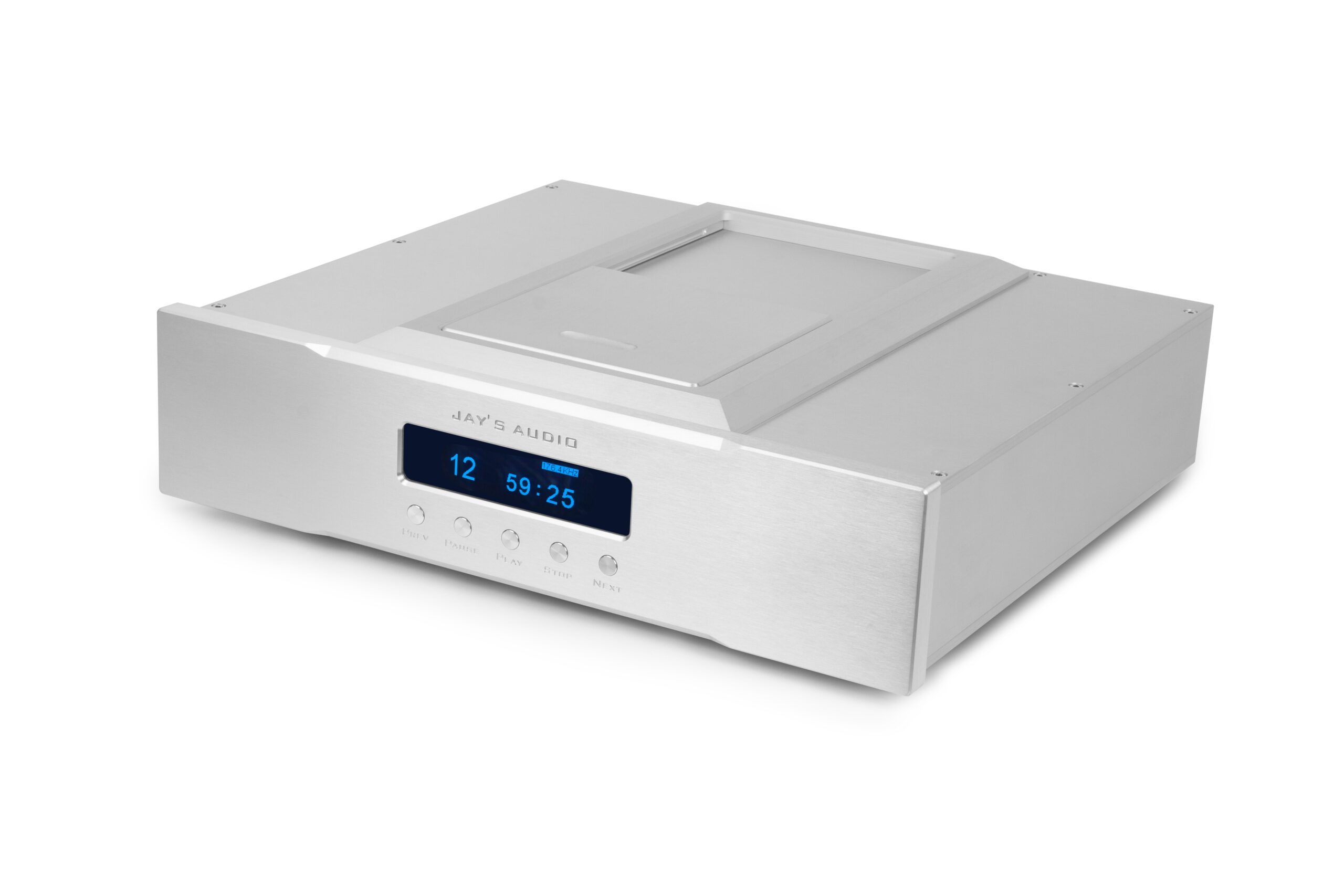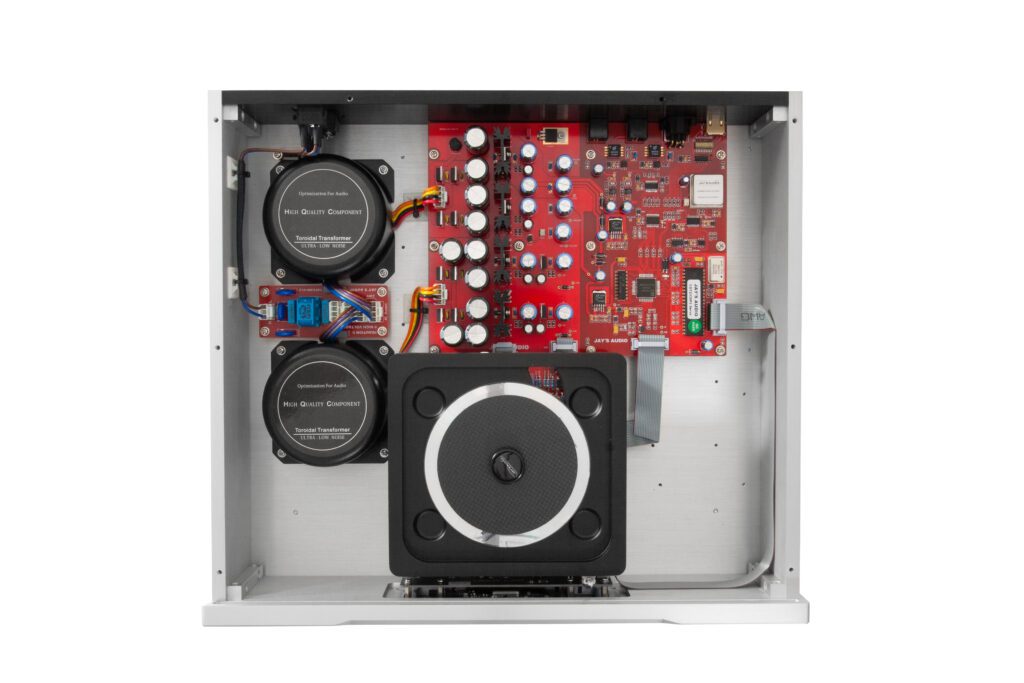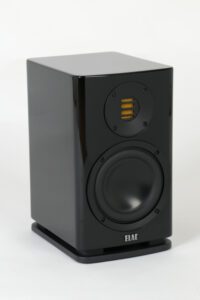
Chinese audio manufacturers have mostly pitched their tents in the high volume, low cost corner of the market. In general, the high-end has been left to western vendors or at least ‘Western design, Eastern build’ products. But it was always only a matter of time.
Audio Music is one of the pathfinders for the Chinese drive into the high-end, offering products underpinned by serious engineering and production values. The company’s RT preamplifier remains one of my personal all-time favourite high-end preamps. It justifies its desirability through sheer sonic quality alone. The comparatively low price – it would likely be four, five times as much with a European or US badge on the front – is simply the cherry on a very tempting cake.
Fewer still will have heard of another Chinese company; Jay’s Audio. It currently offers just three products through a website managed by global distributor Vinshine Audio in Singapore. The company’s CD player, built around a discrete R2R DAC board by Danish specialist Soekris, and the stand-alone DAC using the same core OEM technology, will have to wait for another day. This review considers the CDT2-MK3 top-loading Red Book-only transport. If you want the key take-away up-front, it’s a product that kicks sand in the face of those that assert that no quality audio engineering comes out of China. As with the Audio Music RT preamplifier, the performance/price ratio is off of the scale. Beginning to see a pattern here?
Stout boxing
The CDT2-MK3 review sample arrived stoutly double-boxed. Having often experienced a much longer than advertised burn-in, I was pleasantly surprised to find that the CDT2-MK3, left running 24/7, stabilised around the 400 hour mark, just as predicted by Jay’s Audio. It was placed in a review system comprising a Denafrips Gaia DDC/re-clocker, a Denafrips Terminator Plus DAC, Bryston BP-17 Cubed and 4B Cubed pre- and power-amplifiers, and PMC MB2se speakers. Speaker cables, mains wires and single-ended interconnects were all by Quiescent. AudioQuest and Gothic Audio digital interconnects were also used.
The CDT2-MK3 is available in black anodised or plain brushed aluminium finish and weighs 15 kg. The oh-so-silky movement of the top-loading shutter and the thickness and fit’n’finish of the CNCd aluminium chassis bespeak quality engineering. Even the accompanying remote control is machined from billet aluminium and weighs a hefty 390 grammes.

Undo the eight stainless Allen bolts that secure the transport’s top plate, and inside we find audiophile-grade engineering and component quality. There are two power supplies, one for the drive and its servo circuit, the other for the transport’s DSP and clock elements. Incoming mains is filtered for EMI on a separate board, followed by two potted 50VA Noratel toroidal mains transformers backing over 50,000uFs of Nichicon capacitance and 10 individual DC regulated feeds. The oven-controlled oscillator module with its associated PLL circuit is also a Jay’s design.
Rear Panel Power
Rear panel BNC, S/PDIF, AES/EBU and HDMI/I2S sockets are coupled to the output through isolation transformers. A CDM4/19 CD drive is bolted to a separate high-mass machined chassis and has its own underslung control board that, like the main board, is a proprietary Jay’s Audio design. On the front of the CDT2-MK3 an OLED display shows track and disc information, and buttons allow access to basic functions. Handset buttons enable more advanced track programming and up-sampling to 176.4kHz.
Would a CDT2-MK3 have to be sent back to Singapore in the event of a fault? The answer is that it is designed to allow easy service in the field. The optical drive type is known for a particularly long service life, but should it fail the replacement process is quite literally plug and play. The circuit boards too are designed to be swapped in a similar manner.
Some doubt Jay’s Audio’s claim to have sourced some 3,000 new old stock pieces of the Philips drive, a type that has been out of production for some years. Frankly, I doubt the doubters. Regardless, you’ll soon read why the company is right to be proud of its IP in the circuitry of the CDT2-MK3, and Jay’s Audio would on one hand be mad not to stress the positive, and would likely have later cause to regret the attempted deceit.
And of course, what really matters is how it sounds. The news is that in every key aspect of performance except perhaps subjective background noise, the Jay’s proved equal or superior to the latest three-times-the-cost offering from the company that leads the field in belt-drive CD transports. Out of the box the Jay’s makes a bankable down-payment of sonic value that places it firmly in the high end. Through the burn-in process it matures to offer a particularly well balanced and generous measure of the key musical pillars of dynamic expression and agility, tonal detail, image placement and timing.
Belt Drive
The belt drive transport mentioned just a moment ago was uncannily electrically quiet when I reviewed it, able to draw attention to subtle musical detail that other transports hadn’t revealed. The Jay’s ‘does detail’ to nearly the same degree, but in addition serves up a richer palette of tonal and textural content that makes familiar recordings still more satisfying. And, despite not having the theoretical technical advantages conferred by belt drive, it nonetheless transcribes material with a relaxed flow that somehow just sounds more natural and easy to live with than many alternatives which contrive to sound buttoned-up and overtly digital. A notable transport for any money? Yes. Particularly remarkable for what it costs? Yes again.
Like a growing number of manufacturers on either side of the bamboo curtain including Denafrips, Holo, PS Audio and Rockna, Jay’s Audio is keen on I2S as a way of linking audio components. Unlike coax and AES/EBU, which send everything down the same conductor, I2S uses dedicated conductors for each data type and is less prone to errors because music does not have to be parsed from clock data. So much for the theory. The CDT2-MK3 was the fifth component through my hands in the last six months to demonstrate that while I2S can offer slightly superior separation, well-implemented S/PDIF and AES/EBU, using quality code on a FPGA rather than an off-the-peg receiver chip, remains a solid option. After trying all the possible combinations of cable types I settled on an AudioQuest AES/EBU Diamond cable from transport to DDC and an AudioQuest Dragon HDMI cable from DDC to DAC. A made-in-Manchester solid silver AES/EBU cable by Gothic Audio ran the Diamond a very close second.

Experimenting with the cables types in order to determine the optimum combination, I spent quite a bit of time listening to symphonic recordings. The system as configured demonstrated an impressive ability to resolve such complex material and confirming that the CDT2-MK3 serves up solid timing. I then played the same tracks with the transport connected directly to the Denafrips DAC, without the Gaia DDC/re-clocker in circuit. Sound staging and low-end performance fell back as might be expected, jitter being particularly damaging to these two aspects of performance, but on its own the Jay’s still proved no slouch – evidence that the transport’s own internal oven-controlled clock does a very good job of minimising jitter. A visiting friend, hearing the system in this configuration, commented, “Oh the bass! That’s some grunt.”
He’s Not The Messiah… but he’s not a very naughty boy!
The truth, though, is that the Jay’s Audio CDT2-MK3 is well-balanced and impartial right across the audible bandwidth. Some people are never satisfied, though. Mike Christ (he’s not the Messiah; it’s a relatively common German surname) who runs HEADquarter Audio near Cologne (headquarteraudio.de), sells a range of brands, including Jay’s Audio. While he admires the CDT2-MK3 very much, he felt the standard puck – a plastic disk with a neoprene underside – could be better. His alternative is the £120 QStab puck – 3D printed from a bone-like material – and while it’s designed for the CDT2-MK3, it should work with other top-loading transports that also use the CDM4 drive. I’m not usually a fan of tweaks. I can’t remember the last time I mentioned one in a review, but the HEADquarter QStab puck is winningly complementary, allowing the CDT2-MK3 to resolve even deeper layers of tonal colour, texture and timing.
That doesn’t detract, though, from what Jay’s Audio has achieved with its CDT2-MK3. It is an impressively engineered and fine sounding transport deserving of serious respect. That it costs as little as it does is further reason to pay it attention.
TECHNICAL SPECIFICATIONS
- Type: CD transport
- Transport Mechanism: Philips CDM4/19
- Digital Output: AES/EBU 5Vrms, 110ohm, HDMI I2S LVDS
- Output Sampling Rate: 16 Bit/44.1kHz or 176.4kHz o COAX (RCA/BNC) 2Vrms, 75ohm
- Dimensions: 430mm × 380mm × 120mm
- Weight: 15KG
- Price: £2,398
Manufacturer: Jay’s Audio
URL: jays-audio.com
Distributed by: Willow Tree Audio
Tel: +44(0)7412690415
By Kevin Fiske
More articles from this authorRead Next From Review
See all
PrimaLuna EVO 100 phono preamplifier
- Apr 22, 2024

Reiki Audio SuperSwitch Master Pro + Servant Pro
- Mar 27, 2024

Melco Audio N1-S38 music server
- Mar 27, 2024











